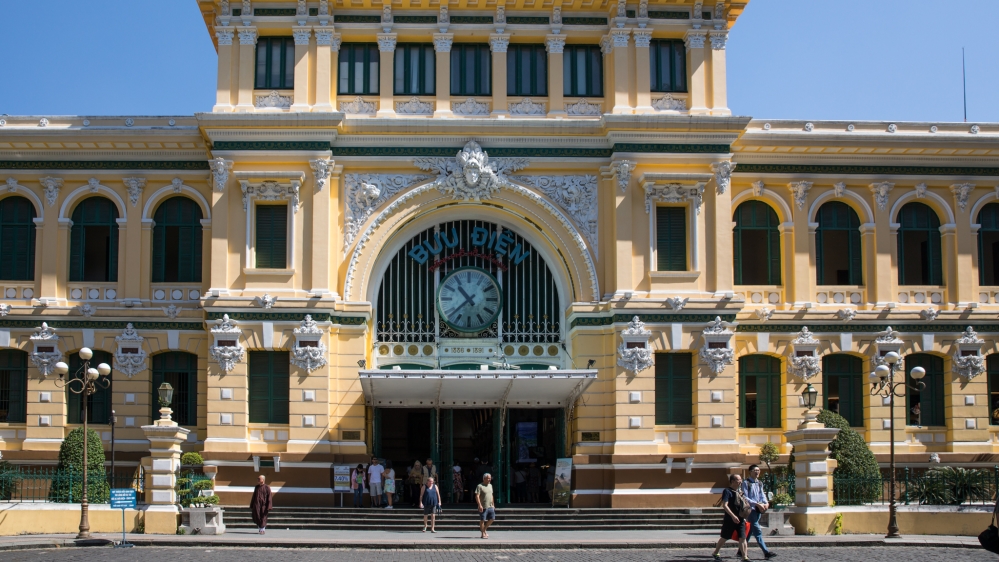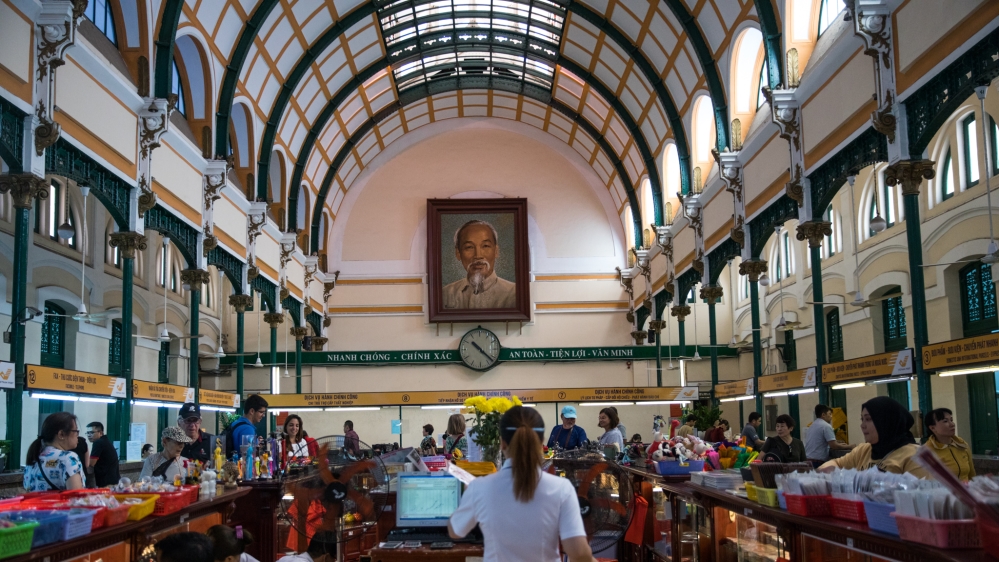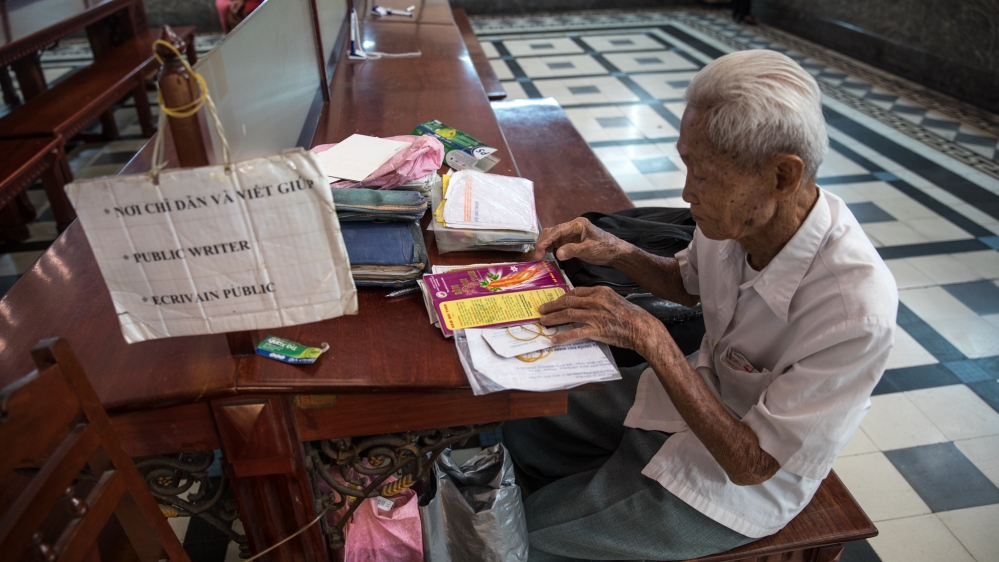Vietnam’s last public letter writer, ‘a witness of Saigon’
Ho Chi Minh City, Vietnam – As Ho Chi Minh City’s iconic French colonial architecture fades away and shiny skyscrapers punctuate the new skyline in the Southeast Asia megacity of 13 million people, there is one man who might be the last vestige of Vietnam’s colonial past.
Duong Van Ngo is the only remaining public writer and still pens letters from the grand 19th century Saigon Central Post Office in Ho Chi Minh City, built when Vietnam was still a part of French Indochina.
Saigon was the capital of South Vietnam before the war and the named changed to Ho Chi Minh City after North Vietnam overtook the city in 1975. Many Vietnamese, especially in the south, and foreigners still refer to the city as Saigon.
Duong Van Ngo held various jobs at the post office before becoming a letter writer.
“I began to work for the post office when I was only 16, in 1946,” the 89-year-old told Al Jazeera, speaking at Saigon Central Post Office.
Every morning, he tapes a piece of paper with the words “Public Writer” in French, Vietnamese and English on a panel near his wooden table, completing his makeshift office.
A large painting of Ho Chi Minh hangs on a nearby wall.
 |
| The Saigon Central Post Office remains one of the most famous landmarks in Ho Chi Minh City and a symbol of French colonial architecture in the city [Valerie Plesch/Al Jazeera] |
Ngo has written letters for hundreds of people in Vietnamese, English and French in the past 28 years.
There were three other public writers when he joined, but they have since all passed away.
He learned French when he was seven years old, which was normal growing up under French colonial rule. English came later, when he was 36 and taught by American instructors.
As he approaches 90, he still travels to work every day on his bicycle.
“Going to work, I feel more joyous than to stay at home,” Ngo said. “I still can serve the public, serve the society.”
But he realises that his profession as a translator and letter writer is becoming redundant given the internet.
“There are many places to make translations but they do not work directly [with people]. Here, I work directly with the people.”
 |
| The interior of the Saigon Central Post Office. The building was completed in 1891 when Vietnam was part of French Indochina [Valerie Plesch/Al Jazeera] |
At 8am every morning, he unpacks his black leather bag, placing a magnifying glass and a weathered copies of English-Vietnamese dictionaries on his table.
Inside the dictionaries, he has scribbled notes marking his own expressions and meanings next to the words.
He also sells postcards to visitors who want him to write something on the spot for 5,000 dong (around 22 cents). He doesn’t charge for his writing, though most customers give him a generous tip.
Most of his visitors are tourists.
But a few people who have known him for 40 years still come to see him at work, such as 60-year-old Mai Dang Guesdon.
“Chao Chu,” she says, the polite way to address an older man in Vietnamese that is akin to “uncle”.
Guesdon was on holiday from France, where she has made her home.
 |
| Duong Van Ngo writes a postcard for a tourist at the Saigon Central Post Office [Valerie Plesch/Al Jazeera] |
She used Ngo’s services in the 1990s to write love letters to her French boyfriend, who she had met in Vietnam while working as a tour guide .
She didn’t speak any French and relied on Ngo to communicate with her now husband. She still keeps the letters written at her home in France.
“It was him who translated for me for many years,” she said. “He works with all his heart … He likes to work; he likes words and letters … He loves French words.”
When asked about writing love letters, Ngo laughed and said: “I only translate them. I do not write them myself.”
During the day, curious tourists come to chat to Ngo.
Some ask him to write letters or postcards for friends and family back in their home countries.
Kim Liong, 40, from Malaysia, said: “It’s like back to the 60s, the olden days. That is how I feel and I love it. If you look at the handwriting, it’s beautiful. You can see that he trained a lot.”
 |
| Duong Van Ngo prepares his writing desk early in the morning inside the Saigon Central Post Office [Valerie Plesch/Al Jazeera] |
Chi Pham, 32, is a tour guide and brings visitors to meet Ngo.
“Every time I take people to the post office, I always try to find him. He’s 89 years old already, and I don’t know how many more times we can see him,” she said.
“As a tour guide, I talk to the people about the city. If there’s something I don’t know, I can ask him, he will explain to me.”
Under Vietnam’s economic and political reforms under Doi Moi in the mid-1980s, Ho Chi Minh City went through a major facelift as foreign investment poured into the city.
“He’s like a witness of Saigon, the one who got the French education during the French era and then before 1975, the democratic time in Saigon or in South Vietnam,” said Pham. “And now, he still appears here in the modern post office. He is the one from the past who still exists here, so it’s very special.”
When asked how much longer he plans on working at the post office office, Ngo said: “I do not know. That depends on God.”




